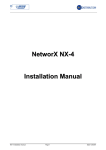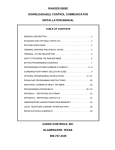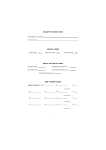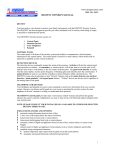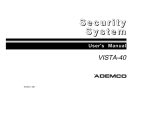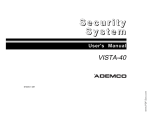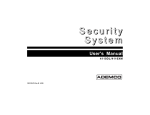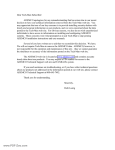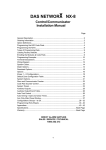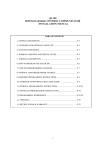Download Destiny 6100 - Allied Fire and Security
Transcript
NOTE: NOTE: When in 2 way mode, the following key functions apply: Digit: 1 2 3 4 5 6 7 8 9 0 = turns on microphone #1 = turns on microphone #2 = turns on microphone #3 = turns off microphone #1 = turns off microphone #2 = turns off microphone #3 = changes to "high microphone sensitivity" = changes to "normal microphone sensitivity" = all microphones on = Exit to keypad mode/or will hang up (programming option) * = Listen # = Talk NOTE: Some central stations may designate other key functions when in 2 way mode. If this is the case, the homeowner "listen in" will follow the new key assignments. New Digit: 1= ____ 2= ____ 3= ____ 4= ____ 5= ____ 6= ____ 7= ____ 8= ____ 9= ____ 0= ____ *= ____ #= ____ TABLE OF CONTENTS INTRODUCTION Control Panel ....................................................................... 3 Detection Devices ............................................................... 3 Telephone Keypads ............................................................. 3 GLOSSARY .............................................................................. 4-5 LOCAL PHONE ACCESS Using Your Telephones As Keypads ..................................... 6 LED INDICATIONS Power .................................................................................. 7 Status ................................................................................... 7 Home .................................................................................. 7 Away ................................................................................... 7 Night ................................................................................... 7 KEYPAD FUNCTIONS Status ................................................................................... 7 Monitor ................................................................................ 7 F1 and F2 ............................................................................ 7 Backlight Intensity ............................................................... 7 CHANGING THE CLOCK TIME ALARM SIGNALS ........................................................................ 8 To set or change the system time, press the 2 & 8 keys simultaneously from a hardwired keypad. The system will respond by speaking "enter four-digit time." Simply enter the time in a 12-hour format. After the time is entered, the system will say "enter (1) AM, (2) PM." After selecting AM or PM, the system will confirm the entered time. If an invalid entry is made, the system will speak "error" and wait for a valid entry. ARMING ................................................................................ 9-11 DISARMING .............................................................................. 11 BYPASS ...................................................................................... 12 CHANGING/DELETING USER CODES ............................... 12-13 PANIC FROM YOUR PHONE .................................................... 13 KEYPAD ACTIVATIONS ............................................................ 13 RESETTING AN ACTIVATED SMOKE DETECTOR ..................... 14 REMOTE PHONE ACCESS ......................................................... 14 OPTIONAL EQUIPMENT Lighting Options ................................................................ 15 Light and Appliance Control Access .................................. 15 2-WAY LISTEN IN ............................................................. 15 - 16 SETTING CLOCK TIME .............................................................. 16 16 Technical Manuals Online! - http://www.tech-man.com The APEX logo is a trademark and DESTINY is a registered trademark of APEX/Division of Pittway Corporation 1 KEYPAD AND PHONE DIGIT QUICK REFERENCE KEYPAD AND PHONE DIGIT QUICK REFERENCE User code +1 .. User code +2 .. User code +3 .. User code +4 .. User code +5 .. User code +6 .. User code +7 .. User code +8 .. User code +9 .. User code +0 .. NOTE: speaks time toggles monitor mode toggles extended monitor A on/off toggles extended monitor B on/off silences day zone speech after activation resets hardwire smoke detector auxiliary user code entry/delete mode speaks long term memory manual bypass mode immediate communicator test (no siren) NOTE: Only "full function" codes can perform the above operations. The DESTINY control panel provides many "convenience related" features and options that greatly enhance the system's interaction with your daily functions. Depending on your system's specific configuration, you may or may not have the following options integrated into your control panel. Enhanced features and options: automatic arming/disarming based on time of day 2-way voice with central station for alarm verification homeowner listen-in from local or remote phones homeowner global paging from local and remote phones automatic control of lights and appliances based on time of day manual control of lights and appliances from keypads, local and remote phones complete energy management functions spoken temperature upon request from keypads, local and remote phones Automatic and manual thermostat setback/forward operation thermostat control by time of day Specialized "convenience" features and options: electric garage door operation from keypads and phones front door visitor-to-homeowner communications without opening door motion activated lighting vehicle activated driveway annunciation The following 2-digit functions are only available from the RK-36 series keypads and not from phones: 2 1 & 3 and/or 3 & status initiate fire alarm 4 & 6 and/or 6 & monitor initiate medical alarm (inside speaker only) 7 & 9 and/or 9 & F1 initiate panic alarm 1 & 7 programmable (default enters remote control) 2 & 8 changes time of day in the system clock 3 & 9 programmable (default toggles monitor function) Technical Manuals Online! - http://www.tech-man.com OPTIONAL EQUIPMENT LIGHTING OPTIONS: OPTIONAL EQUIPMENT LIGHTING OPTIONS: The DESTINY allows you to turn on different lights and/or appliances when using the optional lighting accessories. Different lights can come on for an alarm condition or other system activity such as prealarm (entry delay). Your system can also be programmed to turn lights on or off at certain times of the day, as well as providing you with the ability to control your lights from any keypad, local phone, and/or remote phone to include cellular and cordless types. LIGHTS AND APPLIANCE CONTROL ACCESS: LIGHTS AND APPLIANCE CONTROL ACCESS: From your phones, either locally or remotely, access the system as you normally would (see local and remote phone access) and enter 8,8,8,8. From the keypad, the F1 or F2 keys may be used instead of 8,8,8,8. After entering 8,8,8,8 or F1, the system will speak "enter remote unit," or if programmed, it will speak a menu of the active channels in the system. At this point, enter a two-digit channel number from 01 to 33. Your installer will let you know what channels control which lights or appliances. Channel 33 is an "all lights on/off" channel that can activate a group or bank of lights at the same time. Afte rentering the desired channel, the system will echo your choice by speaking the programmed word descriptions for that channel. To activate the channel, the A or * key turns the unit on, and the H or # key turns the unit off. if the dimming option is enabled, then the successive depressions of the A or * key turns the unit off. If the dimming option is enabled, then the successive depressions of the A or * key will step through the six levels. To exit remote control, enter 0,0 or any F key. If no digit is entered within 20 seconds the system will automatically exit. NOTE: When twenty seconds pass without pressing any keys, the system will automatically exit lights and appliance control and return to normal operation. 2 WAY AND LISTEN IN: NOTE: 2 WAY AND LISTEN IN 1. Access the system (see Local Access or Remote Access) 2. Press 9,9,9,9 to enter "Listen" mode. 3. Press # to talk, * to listen. 4. Hang up when done or press 0 to return to keypad mode. 15 RESETTING AN ACTIVATED SMOKE DETECTOR INTRODUCTION RESETTING AN ACTIVATED SMOKE DETECTOR Whenever any of your wired (non-battery powered) smoke detectors activate the system, they will latch ON until you reset them. To do so, enter your primary code followed by 6. The system will say SMOKE POWER. REMOTE PHONE ACCESS REMOTE PHONE ACCESS Following is a step-by-step description of phone access: 1. Dial your home number from any touch-tone phone. 2. The system will answer after a programmed number of rings and you will hear an acknowledgment tone that your system is ready and waiting. If you have an answering machine, wait for it to answer, then press the programmed override digit within 10 seconds and you will then hear the acknowledgment tone indicating that your system is ready and waiting. 3. You must now enter your disarm code and the system will speak your system status. If you do not enter an acceptable code within 5 seconds of the tone you heard in Step 2, the system will automatically hang up. 4. Now that you have entered your code and have received the system status, your telephone can be used as a keypad. To hear the status of your system again, press the first digit of your disarm code and wait three seconds. The system status will be repeated through your telephone receiver. To disarm the system over the phone, simply enter your disarm code on the telephone keypad. To arm the system, use the * key to arm to AWAY or use the # key to arm to HOME. Once you have finished, simply hang up the phone and the system will hang up at the other end. If you do not press any digits for a period of 15 seconds, the system will automatically hang up. 14 You have made a wise decision to protect your family and property with the DESTINY Security System. The DESTINY has been designed to provide you with a maximum level of security while being as simple as possible to understand and operate. Your DESTINY Security System consists of: You can gain access to the system from any touch-tone phone when you are away from home. If you use an answering machine, your installer will program an override digit which you will use to bypass the answering machine and get directly into the system. NOTE: DESTINY NOTE: Your installer can increase or decrease this time. Technical Manuals Online! - http://www.tech-man.com 1. Control panel 2. Detection devices 3. Your telephones 4. Keypad(s) CONTROL PANEL The control panel is the heart of the security system and includes a communicator which transmits information to the central station. The control panel is housed in a metal cabinet which should only be opened by a qualified security system technician. DETECTION DEVICES The detection devices continually monitor the status of the premises. Switches will alert the control panel of an open door or window. A transmitter will do the same as well as indicate when it has a weak battery. The glass break detector is exactly what the name implies: it picks up the frequency of breaking glass and instantly alerts the control panel. A motion detector is used as a second line of defense to detect intruders within a protected area. The smoke detector is always on. SWITCHES TRANSMITTER GLASS BREAK DETECTOR MOTION DETECTOR SMOKE DETECTOR TELEPHONE KEYPADS Your phones and keypads are used to send commands to your security system. Because your phones and keypads are your access to operating the security system, the main emphasis of this users manual is to help you understand their operation. Before reading this manual, it is recommended that you become familiar with the terms and definitions in the Glossary. POWER HOME STATUS AWAY 1 2 3 STATUS 4 5 6 MONITOR 7 8 9 F1 A 0 H F2 3 GLOSSARY GLOSSARY ALERT ALERT - The "alert" status indicates the system has been tripped. The system will remember the "alert" status until cleared. To clear the "alert" status, simply re-arm the panel. ANNUNCIATION ANNUNCIATION - Beep or speech emitted over the phone or through system speakers to announce activity or report system status. ARM ARM - To turn the security system ON to detect intrusion. There are three modes, or levels, of arming: AWAY, HOME or NIGHT. AWAY AWAY - Arming mode for use when you are AWAY from the premises. All interior and perimeter devices are armed; intrusion and/or movement within the premises will activate the alarm. BYPASS BYPASS - To temporarily remove a zone from the system that would normally be active when the system is armed. If a zone is bypassed, it is not part of the system, and will not initiate an alarm. CENTRAL STATION CENTRAL STATION - If your security system is monitored, this is the agency that receives the incoming burglary or emergency message from the security system and reports it to the proper authorities. The DESTINY allows 32 different disarm codes. Check with your installer to find out how many codes are enabled. To enter or change an auxiliary code; 1. 2. Enter your primary disarm code. Follow steps 2 through 4 above, however, in step 3 instead of entering 1 you will enter the two digit number of the code you wish to initiate or change. One or more of your auxiliary codes can be a disappearing code which is useful for domestic workers, repairmen or anyone whose access to your home you want to limit. Your installer can program the number of times a disappearing code will remain active each time it is assigned. One or more of your auxiliary codes can be used as a duress code. Your installer can program your system so that the use of a duress code will give the appearance of being a normal disarming code. However, even though no alarm is sounded at the location of the security system, there will be a silent alarm signal sent to the central station. For the duress code to function as designated, no normal codes can be the same as any duress code. PANIC FROM YOUR PHONE COMMUNICATOR COMMUNICATOR - The device in the control panel that reports all burglary and emergency alarms to the central station via telephone lines. CONTROL PANEL CONTROL PANEL - The heart of the security system. Only a qualified security system technician should open the container which houses the control panel. NOTE: Never program a disarm code with all zeroes. DISARM DISARM - To turn the security system OFF or silence alarm activations, including fire alarms, that may occur while the system is armed. Simultaneously pressing certain keys on the keypad will result in the following: DISARM CODE DISARM CODE - The three or four digit number you enter to disarm the security system. The system will accept 32 different disarm codes, including disappearing and duress codes. Your disarm code allows you to control the system. ENTRANCE DELAY 4 ENTRANCE DELAY - Time permitted to enter the armed premises and disarm the security system before the alarm is activated. A 20 second delay is set at the factory, but your installer can program a longer or shorter time, as desired. Technical Manuals Online! - http://www.tech-man.com PANIC FROM YOUR PHONE Anytime you have accessed your system from an on-site phone, pressing the 0 key five times in a row will initiate a PANIC alarm. KEYPAD ACTIVATIONS 3 and STATUS - FIRE Alarm 6 and MONITOR - EMERGENCY Alarm KEYPAD ACTIVATIONS POWER HOME STATUS AWAY 1 2 3 STATUS 4 5 6 MONITOR 7 8 9 F1 A 0 H F2 9 and F1 - PANIC Alarm MONITOR - Door & Window annunciator ON with beep, ON with speech or OFF 13 BYPASS BYPASS To enter BYPASS mode, your system must be disarmed. Make sure the system is disarmed and follow the steps below: 1. 2. Enter the two digit number of the zone (use a leading zero if necessary) you wish to bypass. You will hear (description of selected zone) BYPASSED (ON or OFF). Only zones that exist in the system can be bypassed. If an invalid zone number is entered, refusal will be signaled by three beeps. HOME - Arming mode for use when you are at HOME. Only perimeter devices are armed allowing you to move about freely within the premises. The system will be programmed to eliminate all entrance delays when armed to home. This might be preferable for individuals living alone. HOME Pressing 00 while in BYPASS mode will clear all bypassed zones. 5. Press the # or H key to exit BYPASS mode. You will hear EXIT. Assuming your primary code is 1,2,3,4: 12 FORCE ARM 4. CHANGING/DELETING USER CODES 1. Enter 1, 2, 3, 4, 7. 2. The system will speak ENTER USER NUMBER. 3. Enter 2 digit user number, (01-32). The system will speak "ENTER CODE X X" (X X = 01-32) You do not need to clear a code to change a code. 4. Enter the new 4 digit code or hit the A key to delete the user code from step 3. If a new 4 digit code is entered the system will speak EXIT after the 4th digit. If a code is deleted the system will speak CODE OUT. Technical Manuals Online! - http://www.tech-man.com EXIT DELAY FORCE ARM - To override the security system's initial refusal to arm because of an open zone. When the system is force armed it will disregard any open zones until they have been closed. INTERIOR ZONES - Zones consisting of motion detectors or any other detection devices located within the premises. NOTE: If ten seconds pass without pressing any keys, the system will automatically exit BYPASS mode. GLOSSARY, cont. EXTENDED MONITOR - Allows a zone to speak continuously or for a programmable time period when tripped. Example would be "pool door open, pool door open, ..." Press the * or A key. The yellow status led will light to indicate that the zone is bypassed. The RK36 Keypad LCD will display the zone descriptor and beep. A second push of the * or A key within 10 seconds will remove the zone from bypass and the yellow STATUS LED will clear as well as the zone descriptor on the LCD display. 3. NOTE: Enter your code and immediately press the 9 key to gain entry into BYPASS mode. You will hear BYPASSED MODE, ENTER ZONE NUMBER. EXIT DELAY - Time permitted to leave the premises after arming the system. A 30 second delay is set at the factory, but your installer can program a longer or shorter time, as desired. INTERIOR ZONES LCD - Liquid Crystal Display. Will display all system status in English. LCD LED - Light emitting diode. These are used as indicators of system conditions on keypads. LED NIGHT - Arming mode for use when everyone is in for the NIGHT. All perimeter devices become instant and some interior zones can be active. NIGHT PERIMETER ZONES - Zones consisting of door and window contacts and glass break detectors which will detect an intruder before he gains entry into the premises. PERIMETER ZONES PREALARM SPEECH - When the system is armed, and someone enters the premises through a "delay" door, the system speaks "entry detected" followed by the word description programmed for that door. Example: "entry detected, front door...entry detected, front door." This speech will be heard for the duration of the entrance delay. If the disarm code is not entered within the programmed time, theBURGLAR ALARM will sound. If an alarm took place while you were gone, then the system would speak "system showing alert," followed by the prealarm speech. PREALARM SPEECH PREALARM TONE - Steady, low volume sound emitted through the speakers when the entry delay door is opened. This tone will continue until the disarm code is entered to disarm the system. If the disarm code is not entered within the programmed time, the BURGLAR ALARM will sound. A pulsing prealarm tone indicates there was an activation while you were gone. PREALARM TONE ZONE - Any area or point of protection in the security system such as doors, windows, and all other areas covered by detection devices. ZONE 5 USING YOUR TELEPHONES AS KEYPADS 5. Preventing accidental arming: LOCAL PHONE ACCESS USING YOUR TELEPHONES AS KEYPADS The system can be programmed to allow the use of your home telephones as keypads. You will notice that the keypad shown below duplicates the keys on your phone. The * key on the phone is replaced by the A key on the keypad and the # key on the phone is replaced by the H key on the keypad. Your installer will let you know which key or keys will access the system. The local phone access code must be entered within (5) seconds of picking up the phone. If the correct code is entered within (5) seconds, you will hear the system acknowledgement tone or system status. At this point you can control the system from the phone just like from the hardwired keypad. NOTE: NOTE: NOTE: If your regular phone line is out for any reason you will not hear a dial tone when you pick up a phone, however, you will hear a series of tones indicating the line is gone. If this is the case, there is no need to access the system because the phone will already be a system keypad when it is picked up. Press any key and the tones will stop. If your system communicates to a central station and there is an activation, you can pick up a phone and simply enter your disarm code. The system will recognize the phone as a keypad as soon as you pick it up. NOTE: When you access the system from your home phone, your normal incoming phone line is disconnected. In the case of an incoming call you will hear one-second tones similar to call waiting. To answer the call simply hang up to terminate telephone keypad access. POWER HOME STATUS AWAY 1 2 3 STATUS 4 5 6 MONITOR 7 8 9 F1 A 0 H F2 RK-36 KEYPAD MONITOR MODE FROM A PHONE 6 MONITOR MODE FROM A PHONE See RK-36 Keypad description for explanation of "Monitor Mode." To change monitor mode from a phone; access the system (refer to Local Access or Remote Access), then enter the user code plus the 2 digit. This toggles to the monitor mode. Technical Manuals Online! - http://www.tech-man.com If you want to prevent anyone from accidentally arming the system, your installer can program the alarm system to require your disarm code to also serve as an arming code. When programmed to this option, you must enter your code before you press the * or A key (AWAY mode) or # or H key (HOME mode) to arm the system. DISARMING ARMING, cont. PREVENTING ACCIDENTAL ARMING: DISARMING How to TURN OFF the alarm system Enter your disarm code. When the system is disarmed, you will hear CONTROL IS DISARMED over the phone or through the speaker and the red HOME LED and/or green AWAY LED will go out. When you open the entry door while the system is armed to AWAY, you may hear PRE-ALARM spoken instead of hearing the tone. This is the prealarm tone and it will continue until you enter your disarm code. You have 20 seconds to disarm the system before the BURGLAR alarm will activate. Your installer can program a longer or shorter entry delay time, at your request. If the prealarm tone is not a continuous, steady tone, but is instead a series of broken tones, this is an indication that the security system was activated while you were gone, and the yellow STATUS LED will be flashing. In the unlikely event of a FALSE or ACCIDENTAL ALARM, enter your code to disarm the system and stop the audible alarms. Check with your installer and/or central station to determine the proper procedure for dealing with false or accidental alarms. Depending on the structure of your central station, you may need to notify the central station or they may call you. In either event, be prepared to recite your central station account number or abort code to verify your identity. 11 ARMING RK-36 KEYPAD LED will not light and you will hear the system say ZONES OPEN over the phone or through the speaker which indicates that the system did NOT arm. See "Force Arming" to continue. ARMING THE SYSTEM TO NIGHT:(OPTIONAL) 3. Arming the system to NIGHT: (Optional) Arm the system to HOME mode. (See item 2) PUSH THE # OR H KEY AGAIN. FORCE ARMING THE SYSTEM: Push the # or H key again. The green AWAY LED will light with the red HOME LED and the system will say ARMED TO NIGHT over the phone or through the speaker. When armed to the NIGHT mode, the perimeter entry delay zones become instant and your installer may program some interior zones to be active. If you wish to return to the HOME mode, simply push the # or H key any time the system is in the NIGHT mode. 4. Force Arming the system: If you attempt to arm the system to either HOME or AWAY but you hear ZONES OPEN over the phone or through the speaker and notice that neither the HOME LED nor the AWAY LED has come on, the system is NOT armed. However, the system can be FORCE ARMED. Push the # or H or * or A key a second time within 10 seconds. If arming to HOME, the red HOME LED will now light and FORCE ARMED TO HOME will be heard indicating that the system is now ARMED to HOME. If arming to AWAY, the green AWAY LED will now light and FORCE ARMED TO AWAY will be heard. When FORCE ARMED either to HOME or AWAY, the yellow STATUS LED will be lit. You can find out which zones are open by requesting system status. PLEASE NOTE: PLEASE NOTE: When you FORCE ARM your system, security is compromised because the open zone will be ignored by the system. Check with your installer to determine how the open zone will again be part of the system. Zones which operate 24 hours a day such as FIRE and PANIC are always armed and take priority over all other types of protection in the system. 10 Technical Manuals Online! - http://www.tech-man.com RK-36 KEYPAD - LED's and SPECIAL KEYS POWER On when AC or back-up battery power is present. If AC power is lost the STATUS LED will flash, and the system will speak "POWER OFF" one time. GREEN POWER STATUS Flashing when new information is available, solid after status has been asked for and spoken, and off when no information is present. HOME On when armed to HOME. Press H to arm to HOME. YELLOW STATUS RED HOME GREEN AWAY On when armed to AWAY. Press A to arm to AWAY. AWAY NIGHT Both HOME and AWAY LED's are on when armed to NIGHT. Press H any time system is armed to HOME to change to NIGHT. Pressing H when system is armed to NIGHT will change arming back to HOME. STATUS Pressing this key will cause the system to immediately speak system status. MONITOR Pressing this key toggles the system between the three possible monitor conditions. Monitor On - System will announce doors and windows when opened. Monitor Off - System will not announce doors and windows when opened. Beep - System will beep when doors and windows are opened. F1 and F2 These key's functions are programmable and will be explained by your installer. F1 ________________________ F2 ________________________ STATUS MONITOR F1 F2 BACKLIGHT INTENSITY You can control the brightness level of the key backlighting. The simultaneous depression of the 4 and 7 keys will step the backlighting through 7 different levels. Press 4 and 7 simultaneously a number of times until the backlighting is totally off. We will define all backlighting off as level 1. Levels 2 through 7 will take the key backlighting through 6 progressively brighter levels. 7 ALARM SIGNALS ARMING ALARM SIGNALS Understanding the alarm signals: FIRE Alarm: a continuous, steady, loud tone emitted through the speakers. Your installer may also program the system to speak in between tones saying FIRE, (description of zone that activated), REMAIN CALM, LEAVE IMMEDIATELY. EMERGENCY Alarm: a low pulsing tone is emitted through the speakers. Your installer may also program the system to speak in between tones saying ALERT, (description of zone that activated). PANIC Alarm: a loud pulsing tone is emitted through the speakers. Your installer may also program the system to speak in between tones saying ALERT, ALERT, (description of zone that activated). BURGLAR Alarm: a loud yelping tone is emitted through the speakers. Your installer may also program the system to speak in between tones saying INTRUSION DETECTED, INTRUSION DETECTED (description of the zone that activated). PREALARM tone: a steady, low volume tone emitted through the speakers during the entrance delay. This tone is activated by opening the delay door and will continue until the security system is disarmed. If the system is not disarmed within the programmed delay time, the BURGLAR alarm will sound. A broken or pulsing prealarm tone signals that an alarm activation has occurred while you were gone. If the option is programmed to speak during prealarm, the system will speak entry detected, followed by the zone descriptor, instead of a solid prealarm tone. DOOR & WINDOW ANNUNCIATOR: The system will speak up to four words describing a zone followed by the word OPEN. If you would prefer not to hear anything when you open a window or door, simply access the system from one of your phones and press your code followed by 2 or press the MONITOR key at an optional keypad and you will hear MONITOR OFF. Now each time you open a protected door or window there will be status available over the phone and/or visual indication at the keypad, but no sound. If you prefer to hear a beep when you open, enter your code followed by 2 or press the MONITOR key again. You will now hear one beep. Enter your code followed by 2 or press the MONITOR key and you will hear MONITOR ON and the system will return to speech. No monitor will be heard for a door or window that is bypassed. 8 Loss of AC power signal: Anytime that you lose AC power, your security system automatically switches to the backup battery and speaks POWER OFF one time through the speaker. Technical Manuals Online! - http://www.tech-man.com ARMING When referring to operation from a phone, the following instructions will assume that access to the system has already taken place. Remember, your installer has programmed a one to four digit code which you will enter when you pick up the phone to get access to the system. How to TURN ON the alarm system to provide protection: 1. Arming the system to AWAY: Push the * or A key. If no zones are open, the green AWAY LED will light and the system will say ARMED TO AWAY over the phone or through the speaker. ARMING THE SYSTEM TO AWAY: OR A PUSH THE KEY. * The security system is now on, or armed. When armed in the AWAY mode, all interior zones, including motion detectors, become active, as well as all perimeter zones. If any zone is open while attempting to arm the system, the AWAY LED will not light and the system will say ZONES OPEN over the phone or through the speaker, indicating that the system did NOT arm because a window or door is OPEN. See Force Arm to continue to arm. After you have ARMED the system, you must leave through the designated entry/exit door within the specified exit delay time. Your installer can program the exit delay time you desire. NOTE: NOTE: If a zone is opened before the exit delay expires, or the system is force armed, then that zone will not be part of the system until that zone is closed. 2. Arming the system to HOME: Push the # or H key. ARMING THE SYSTEM TO HOME: PUSH THE # OR H KEY. If no zones are open, the red HOME LED will light and you will hear the system say ARMED TO HOME over the phone or through the speaker. The security system is now on, or armed. When armed to the HOME mode, only the exterior, or perimeter, zones are armed. This will allow you to move about freely within your home. If any zone is open while attempting to arm the system, the HOME 9










